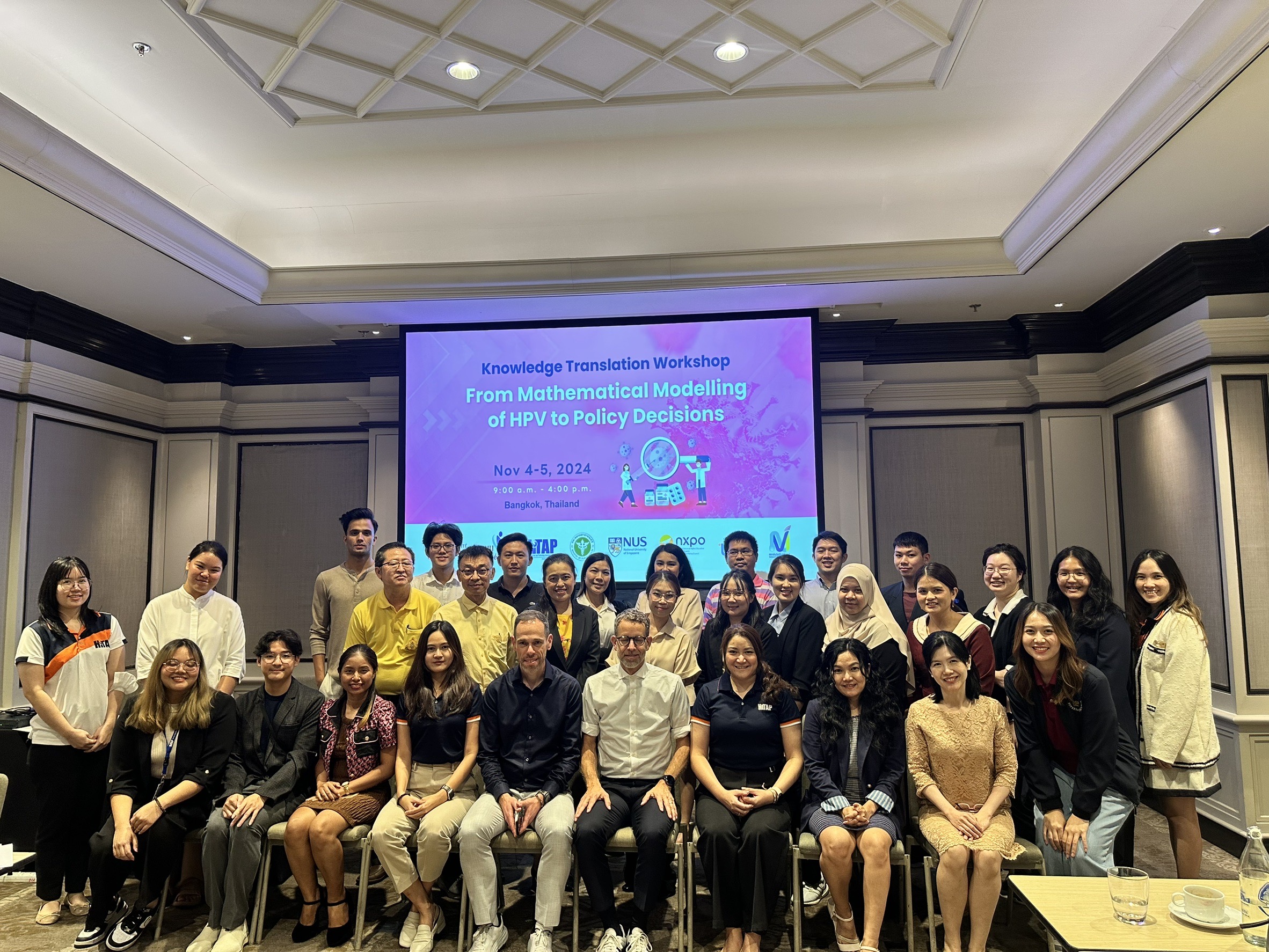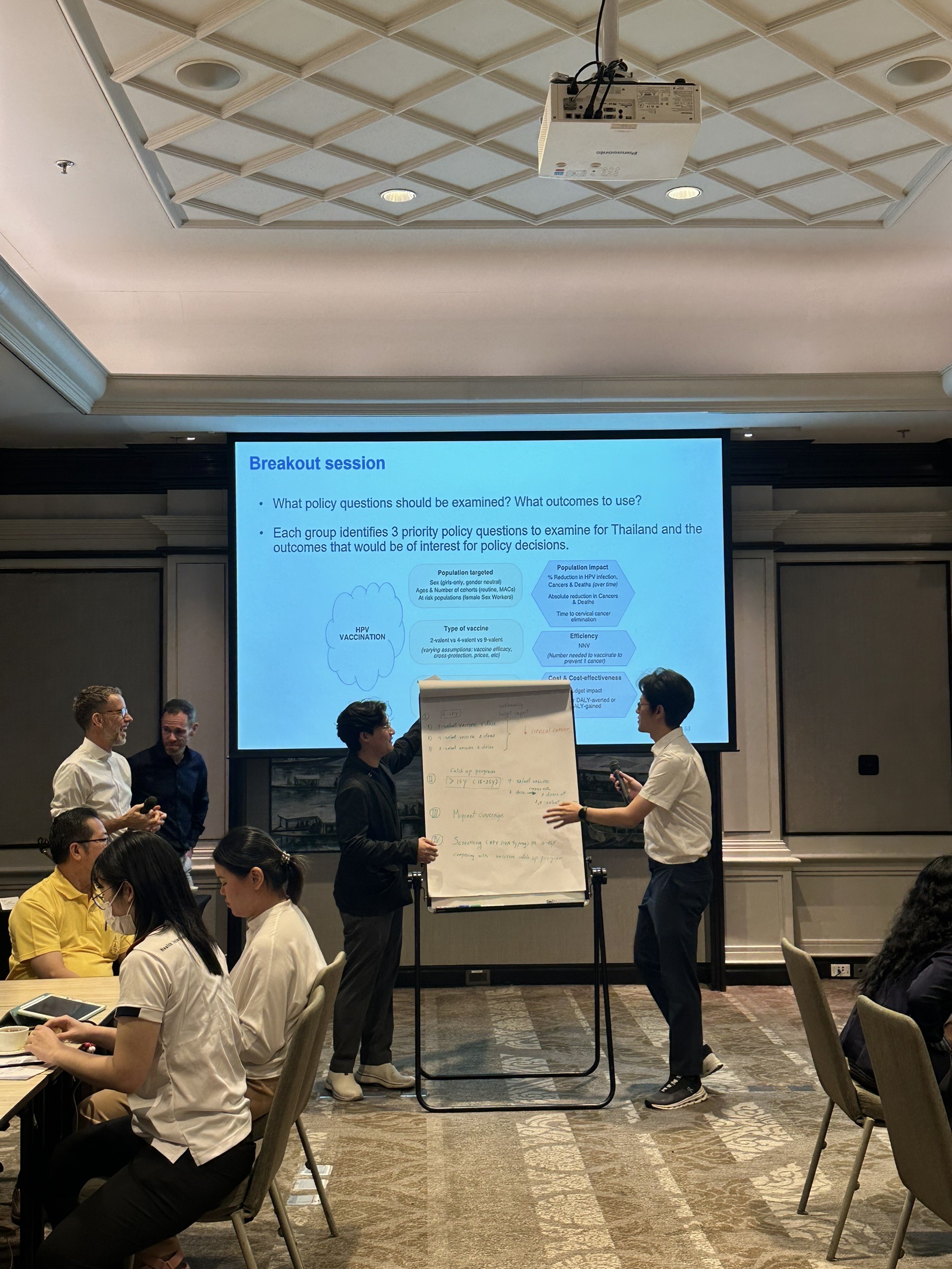
This article is part 1 of the blog series: “Knowledge Translation: The Key to Turning Mathematical Models from a Black Box into a Powerful Tool for Policy Decision-Making”
As health systems become more complex, decision-makers need tools that can help them evaluate long-term outcomes and choose the most effective interventions. Mathematical modeling is one such tool. In Thailand’s efforts to strengthen its Human Papillomavirus (HPV) vaccination program, models have been used to simulate disease trends, assess different strategies, and support evidence-based policymaking. However, the benefits of modeling depend not only on technical accuracy, but also on how well the results are understood and applied.
This first blog in a two-part series explores why mathematical modeling is important for public health and examines the challenges of using models in real-world policy settings.
Thailand’s HPV Vaccination Journey: Expanding Access and Planning for the Future
Since 2017, Thailand has implemented the Expanded Programme on Immunization (EPI), providing a two-dose schedule of 2-valent (2vHPV) or 4-valent (4vHPV) HPV vaccines to girls in Grade 5 and those aged 11–12. Building upon this foundation—and in response to the global HPV vaccine shortage—Thailand has continued to make progress in improving access to HPV vaccination.
Various approaches have been implemented in recent years. The “Quick Win” vaccination programme (a special campaign titled “100 Days, 1 Million Doses”) was launched to vaccinate older girls up to 20 years old. In parallel, The country built a strong collaboration to transfer and establish local midstream technology for producing the 9-valent HPV vaccine, ensuring timely access, sustainable supply, and national self-reliance while preventing shortages like those experienced in the past. This innovation has significantly improved accessibility to the 9-valent HPV vaccine, which offers broader protection against high-risk HPV strains and creates new opportunities to expand vaccination to additional age groups
As Thailand navigates these efforts and plans for the future, an important question arises: how can we evaluate the long-term impact of different vaccination strategies across diverse population groups? To make the most of future HPV program implementation, decisions must build upon the existing program. However, the current landscape is already complex—featuring variations in vaccine types, delivery platforms (routine vaccination and one-off catch-up), and coverage levels across different years. This shift in vaccine policy makes it challenging to determine the most efficient path forward.
Why Mathematical Modeling Matters
Decision-makers are often confronted with policy dilemmas, not only due to the diverse needs of different population groups to vaccinate, but also because today’s public health outcomes result from overlapping policies that have changed over time. This makes it difficult to determine which interventions truly worked, which need improvement, and whether the current situation still requires any additional or more effective interventions. This is where mathematical modeling becomes essential. Models are powerful tools that simulate the spread of diseases, estimate the potential impact of interventions, and forecast outcomes under various scenarios. (1)
Infectious disease modeling supports decision-making in several ways: by predicting trends in disease burden, testing scenarios to explore the impact of policy changes, disruptions, or new technologies before they are implemented, and assessing cost-effectiveness to inform the selection of interventions (2). These capabilities help policymakers ask critical “what if” questions and assess the potential consequences before making real-world decisions. Without modeling, decisions may rely solely on historical data and on limiting the ability to see long-term outcomes. Worse still, critical strategies might be missed, or resources could be misallocated. In today’s increasingly uncertain world, mathematical modeling is not just conceptualized in the ideal world, it’s a necessity tool to be adapted for forward-thinking public health planning.
COVID-19 Case Study
Thailand has already seen the value of modeling in action. During the COVID-19 pandemic, models played a key role in guiding decisions on lockdown timing, vaccine prioritization, and public health responses (3,4).For instance, a study by Wang et al. (3) developed an age-structured transmission dynamic model tailored to the Thai context to assess optimal COVID-19 vaccine characteristics and evaluate preferred vaccination strategies for Thailand. The model provided valuable evidence to support decision-making on how to secure the most suitable vaccine options under various constraints efficiently. However, the study suggested that even when vaccines are available, social distancing measures should still be implemented alongside a vaccination strategy. This example illustrates how dynamic modeling can inform complex decisions in real-world settings and provide timely insights for national policy responses.
Applying Models to HPV in Thailand
To evaluate future HPV vaccination strategies in Thailand, it is important to use a dynamic mathematical model that reflects how past programs have varied across the population. This approach makes it possible to conduct an accurate and context-specific economic evaluation. Recognizing this complexity, health economic researchers at Health Intervention and Technology Assessment Program Foundation (HITAP)—assigned by the National Vaccine Institute of Thailand to evaluate the country’s HPV vaccination program—chose to apply a dynamic transmission model that could address these challenges.
HPV-ADVISE (5,6), an internationally recognized model developed by experts from Laval University, is well-suited to this evaluation. It is a transmission-dynamic model of HPV infections and related diseases that incorporates herd immunity and HPV-related cancers. Therefore, it can be used to evaluate the impact of vaccinating boys as well as the indirect effects of vaccination through herd protection.
The ‘Black Box’ Problem
Mathematical models provide many advantages for public health planning. However, dynamic models are often considered “black boxes” because they contain complex formulas and technical details that can be difficult for those without a background in modelling or statistics to understand. This complexity isn’t meant to confuse—it arises from the need to realistically simulate how diseases spread and how interventions, like vaccines, affect the population. To do this, researchers must incorporate a wide range of variables, assumptions, and mathematical functions. The result is a model that can appear opaque to outsiders, even though it is built on rigorous logic and data.
Once developed, models in economic evaluation for health intervention often integrate data from multiple disciplines, such as epidemiology, demography, and economics. (7). When the model is designed to inform policy, it is essential to involve decision-makers early in the process, as seen in guidance on use of modelling for policy responses to COVID-19. (8) Including the policy marker helps ensure that the model is not only technically robust but also relevant and usable in real-world policy contexts.
Without clear communication between modelers and knowledge users, it becomes difficult to understand how conclusions are drawn. This lack of transparency can lead to mistrust and delay the implementation of crucial health policies.
Thailand’s experience demonstrates the value of modeling in designing effective vaccination strategies. However, it also highlights a key limitation: if the model’s assumptions and results are unclear to policymakers, its impact may be limited. In the second part of this series, we will look at how Thailand addressed this challenge through a Knowledge Translation (KT) process, helping turn complex evidence into actionable policy insights.
Writer
Phornnaphat Chertchinnapa
The writer acknowledges the use of OpenAI’s ChatGPT (July 2025 version) for grammar checking and phrasing assistance.
Interviewee & Reviewer
Dr. Manasanan Khansai/Dr. Manatsanan Khansai
Editor
Dr. Thanchanit Thaipitakwong
Reference
- Cassidy R, Singh NS, Schiratti PR, Semwanga A, Binyaruka P, Sachingongu N, et al. Mathematical modelling for health systems research: a systematic review of system dynamics and agent-based models. BMC Health Serv Res. 2019 Nov 19;19:845.
- Pung R, Kucharski AJ. Building in-house capabilities in health agencies and outsourcing to academia or industry: Considerations for effective infectious disease modelling. Epidemics. 2024 Dec 1;49:100802.
- Wang Y, Luangasanatip N, Pan–ngum W, Isaranuwatchai W, Prawjaeng J, Saralamba S, et al. Assessing the cost-effectiveness of COVID-19 vaccines in a low incidence and low mortality setting: the case of Thailand at start of the pandemic. Eur J Health Econ. 2023 July 1;24(5):735–48.
- Luangasanatip N, Painter C, Pan-ngum W, Saralamba S, Wichaita T, White L, et al. How to model the impact of vaccines for policymaking when the characteristics are uncertain: A case study in Thailand prior to the vaccine rollout during the COVID-19 pandemic. Vaccine. 2023 July 25;41(33):4854–60.
- Brisson M, Boily MC. TECHNICAL APPENDIX HPV-ADVISE LMIC.
- Drolet M, Laprise JF, Martin D, Jit M, Bénard É, Gingras G, et al. Optimal human papillomavirus vaccination strategies to prevent cervical cancer in low-income and middle-income countries in the context of limited resources: a mathematical modelling analysis. Lancet Infect Dis. 2021 Nov;21(11):1598–610.
- CDC. CFA: Behind the Model. 2025 [cited 2025 Oct 15]. Behind the Model: How Scenario Modeling Can Inform Public Health Decision-Making. Available from: https://www.cdc.gov/cfa-behind-the-model/php/data-research/scenario-modeling/index.html
- HITAP. Full report: Guidance on use of modelling for policy responses to COVID-19 – HITAP [Internet]. 2020 [cited 2025 Oct 15]. Available from: https://www.hitap.net/en/document/covid19-policy-modelling-guidance/
- Chaikledkaew U, Kittrongsiri K. Guidelines for Health Technology Assessment in Thailand (Second Edition)-The Development Process.



